Contents
Valuy (lat. Russula foetens) is a mushroom of the Russula family, quite common in Our Country. In the common people, it is also called a goby, svinur, kulbik, cowshed, plakun mushroom. Some of the names are explained by the rather unpleasant and pungent smell of valuya, and the other by the fact that his hat is sticky to the touch.
Where the valui grows
The habitat of the valuya is quite extensive – it is found in large quantities in Eurasia and North America. In Our Country, the places of greatest distribution are in Western Siberia, the Far East and the Caucasus.
Valui is found in all types of forests. This is explained by the fact that it can form mycorrhiza with both coniferous and deciduous trees, but most often the fungus takes place under birch trees. In addition, this species can be found in shady and swampy places, as it loves moisture.
The mushroom usually bears fruit in groups, but single specimens are also found.
What does the value look like
The cap of a mature fruiting body can reach 7-15 cm in diameter and 3-5 cm in height. It is painted in light brown shades. A characteristic feature is the presence of a small hole in the very center of the cap. To the touch, the surface of the mushroom is very slippery and sticky. Despite the fact that in adult specimens the hat is rather flat, in young valuers it looks more like an egg, which gradually opens. Radial stripes are clearly visible along the edge of the cap.
The hymenophore plates are long, often located. They are cream colored, sometimes off-white. A translucent yellowish liquid is released from them, which leaves yellowish-ocher stains on the stem. They darken over time.
The leg is strong enough. In height, it reaches an average of 6-12 cm, while the diameter of the legs can be 3-4 cm. It resembles a barrel in shape. The structure of the stem is quite dense, but there are also hollow specimens. In old values, they become loose, as an irregularly shaped empty space forms inside them. The base of the leg becomes stained over time.
The pulp is quite brittle, fragile. On the cut, it has a white color, but quickly darkens and acquires a brownish tint. The raw pulp tastes very bitter and burning, it also has an unpleasant smell. The reviews note that it is somewhat reminiscent of the aroma of spoiled butter.
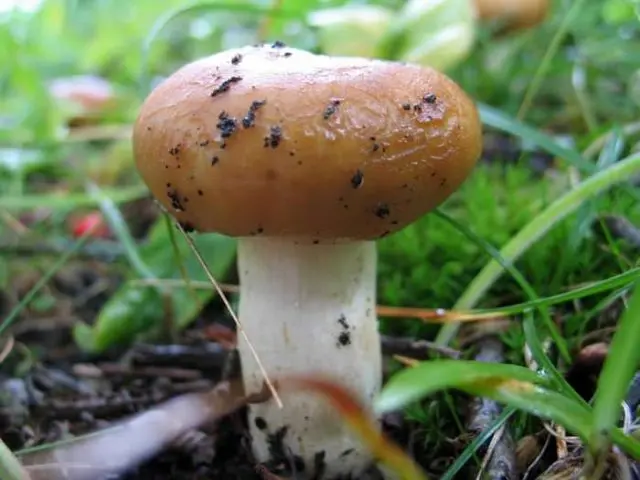
Is it possible to eat valuuy mushroom
Valuy is classified as a conditionally edible mushroom. This means that it can be eaten only after cooking – for this, the harvested crop is soaked or boiled for a long time. It is also necessary to remove the skin from the fruiting bodies, as it is very bitter.
The taste of the mushroom
The taste qualities of the fungus are at the level of the third group. Without additional processing, it is extremely unpleasant in taste, which is why valui are usually salted and pickled. Also in Our Country, dishes from fried and stewed valui, previously soaked, are popular. The pleasant taste of these mushrooms is especially noted in the form of salty snacks that can be cooked cold or hot. Also, in order to give the valuers additional notes, the blanks are seasoned with marinade with spices.
Benefits and harm to the body
Valui has a lot of useful properties, which made it very popular in traditional medicine, especially in China. In Our Country, the mushroom is not used for medicinal purposes, but its benefits are obvious. Properly processed fruit bodies can have the following effects on the human body:
- remove toxins and toxins, being a powerful antioxidant;
- stabilize the work of the heart;
- lower blood sugar levels;
- normalize the metabolism;
- strengthen the immune system;
- promote the removal of heavy metals from the body.
Of course, all this is true only with moderate use of valuu dishes for food. In addition, this species is rich in protein, which is involved in the formation of new cells. The vitamin composition of fruiting bodies is also quite extensive.
Despite the obvious benefits of this fungus for the human body, it also has a number of contraindications. In no form should these forest fruits be eaten:
- children under seven years of age;
- pregnant women and nursing mothers;
- people with diseases of the gastrointestinal tract;
- with individual intolerance to the components contained in mushrooms;
- persons with diseases of the liver and kidneys.
In addition, you can not eat fresh valui. Without additional processing, they cause severe poisoning, which is determined by the following signs:
- nausea;
- thirst;
- vomiting;
- labored breathing;
- disorder of the gastrointestinal tract;
- severe pain in the abdomen.
If these symptoms of poisoning appear, you should immediately call an ambulance. Prior to her arrival, the victim is artificially induced to vomit and the stomach is washed.
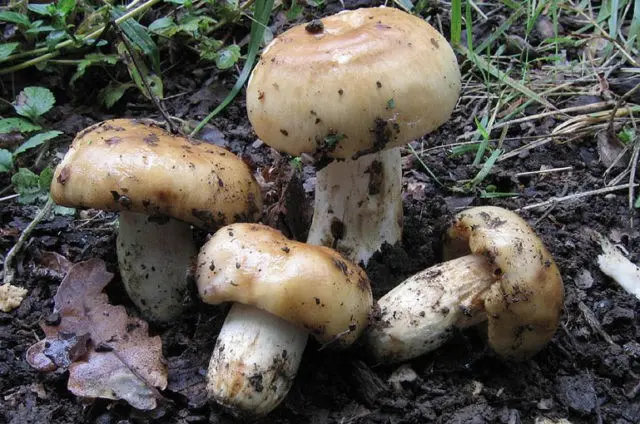
False doubles
The valui has some of its relatives that can cause serious food poisoning. Before going to the forest, it is important to familiarize yourself with the description of these false species so as not to harm your health.
The most dangerous twin of valuing – Hebeloma sticky (lat. Hebeloma crustuliniforme) or false value. In the common people, this species is called horseradish mushroom.
A distinctive feature of hebeloma is a sharp and unpleasant smell, reminiscent of horseradish. In addition, this mushroom is distinguished from edible varieties by the fact that it is never wormy. This is explained by the high content of rather caustic milky juice in its fruiting body.
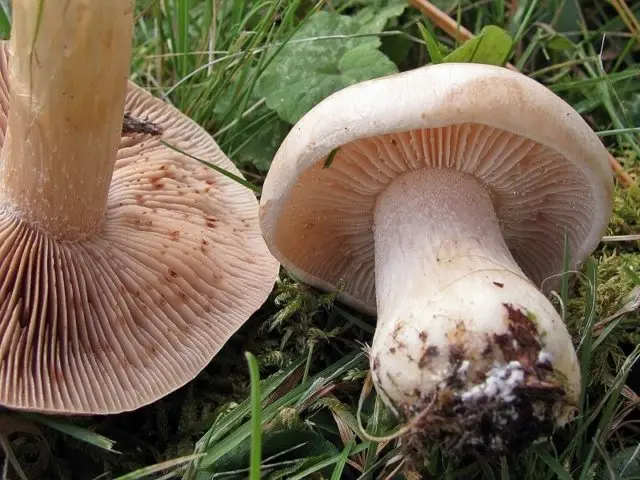
Russula almond (lat. Russula laurocerasi) or russula cherry laurel is also very similar to valui, however, they are easy to distinguish by smell – the aroma of this species gives off strong notes of bitter almonds. In general, almond russula is slightly smaller and more elegant than valuya.
The mushroom is classified as edible, unlike valuya. The taste of this species is most fully revealed during heat treatment, but it can also be eaten raw.
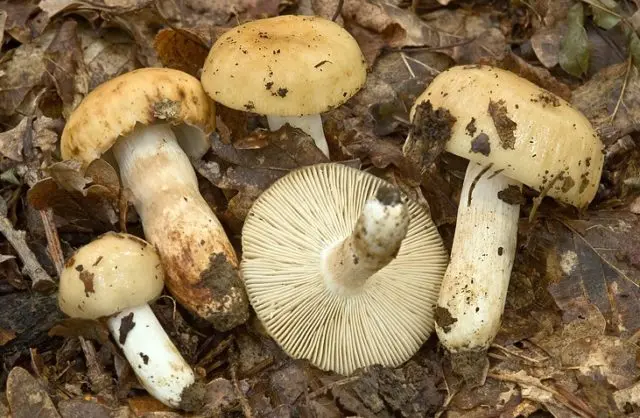
Basement (lat. Russula subfoetens) is practically indistinguishable from valuya. They can only be identified by applying potassium hydroxide (KOH) to the stems of the mushrooms – staining of the pulp should occur at the basement, while the color of the fruiting body of the valuya will remain unchanged. On the other hand, it is not scary to make a mistake in these types, since their taste is not much different from each other.
In the same way as a real valuuy, the basement belongs to conditionally edible mushrooms.
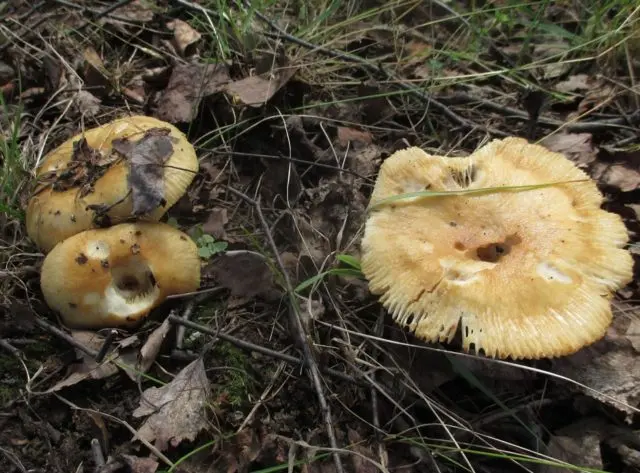
Another common double value – Russula Morse (lat. Russula illota). This species is also distinguished from real valuya by smell – russula has an almond flavor, which its relative does not have.
The mushroom can be eaten, it belongs to the category of edible.

Collection rules
This species is harvested from July to September, sometimes the harvest season stretches until mid-October if the year is warm. In this case, it is recommended to adhere to the basic rules for picking mushrooms:
- They go to the forest in the morning, when the level of humidity is still quite high. In such conditions, the collected fruiting bodies remain fresh longer.
- As with other mushrooms, the valui should not be pulled out of the ground. The mushroom is removed from the soil by carefully twisting the stem or carefully cutting it off just above the ground. Such accuracy is necessary in order to keep the mycelium intact – so it can bring the next year’s harvest. If the mushrooms are pulled out, she will die.
- During harvesting, you should focus on young mushrooms. Old and overripe valui do not have good taste, so they usually collect specimens with hats, the size of which does not exceed 5-6 cm.
Use
Valuya flesh has a rather unpleasant taste when raw. So much so that in the West the mushroom is considered inedible. In Our Country, salted blanks are made from it for the winter, soaking for a long time before that in order to remove bitterness from the fruiting body. In Ukraine and Belarus, mushroom caviar from valuya is very popular.
In general, the process of preparing a valuu is as follows:
- First of all, the fruiting bodies are thoroughly washed from the earth, leaves and other debris, after which the bitter skin is carefully removed from them.
- The next step is to soak the mushrooms. This is necessary in order to remove the unpleasant odor and bitterness. It takes an average of 2-4 days to soak, while using cold water. The liquid is changed twice a day so that the mushrooms do not turn sour.
- The soaking procedure can be replaced by boiling – heat treatment allows you to significantly reduce the time for preparing the crop for salting. To do this, the washed fruit bodies are put in a saucepan and filled to the top with water. Cook mushrooms for at least 40 minutes, after which they can be used for winter harvesting.
This species is unsuitable for drying, as its pulp is too bitter. It is also not recommended to use legs for blanks, usually only hats are selected.
Conclusion
Valuy is a rather difficult mushroom to prepare, however, preparations from it are excellent. At the same time, valui is still not recommended to be eaten by young children, pregnant women and people with diseases of the gastrointestinal tract, since the slightest mistake in cooking can be harmful to health. Insufficient soaking of the mushroom does not threaten serious problems, but a small food poisoning will follow after this.
For more information on how to collect value, you can learn from the video below:









